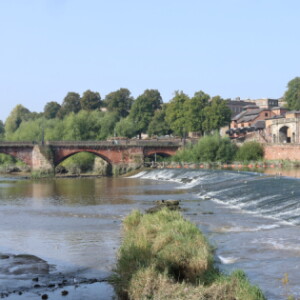The Chester Weir
Main blip - a heron hunting for food on the Chester Weir. Extra - a view of the Weir, with the Old Dee Bridge.
My sources are in disagreement on the Weir. Pevsner says is is a natural rock shelf that runs diagonally across the river. All other sources say that it was constructed in 1093 by Hugh Lupus, first Earl of Chester, to power the tidal mills which were such a feature of the Dee here up to the early part of the 20th century. I suspect it’s a mixture of the two - a rock shelf that was reinforced and that formed the basis of a major construction. Commenced about the same time as the founding of the Benedictine Abbey that became Chester Cathedral at the reformation, and all part of the Normans consolidating their rule in England - and into Wales.
The river here is interesting. Downstream it is tidal, and indeed from the Roman period and for centuries thereafter Chester was the primary port in the north west of England. Then the Dee gradually silted up and the port was abandoned - a flat area called The Roodee, just outside the city walls, most of it was developed into Chester Racecourse.
Upstream of the Weir it is only affected by the highest tides. Used for recreational purposes now, United Utilities extracts water from the Dee here to serve the needs of The Wirral. I read a fascinating article the other day about how we are abstracting far more water from rivers and aquifers than is replenished by precipitation, which is going to cause us huge issues in years to come. This country’s failure to plan strategically for infrastructure because of short-sighted budgetary considerations and short-term political expediency is a whole other topic however.


Comments
Sign in or get an account to comment.


